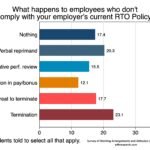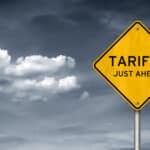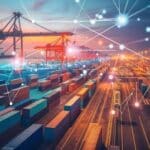Expect More Disruption and Workforce Woes in 2024
First off, Happy New Year from Tompkins Ventures!
As many of us commute back into the office this week (or, better yet, walk to our work-from-home office), I figured we would kick off 2024 with a look back at some highlights of 2023. These top 10 blogs (based on your readership) contain a mixture of advice, insights on current trends and analysis about where the future will take us.
Just like 2020-2023, expect 2024 to be a year where the new normal is disruption. Already in this short year, shipping giant Maersk has decided to avoid the Suez Canal. War continues to threaten that vital artery, which was closed for eight years between 1967-1975. With drought continuing to curb transits through the Suez Canal, companies will face tough decisions about sourcing and shipping.
1. The China Decoupling Might Hit Before You Are Ready
This is not the only time Tompkins Ventures discusses the impact of diversifying supply chains away from China. But it was the most popular for our readers.
China is not going anywhere. Absent a shooting war, the West’s trade with China should continue to grow. But you never know when governments in other countries will target your business operations.
Supply chain resilience comes from optionality – considering multiple alternate production, logistics and transportation solutions. Reducing dependency on any single country or region can help your company survive the whims of foreign governments.
2. The New Era of Supply Chain Leadership: Tabled but Not Enabled
This was an a-ha! moment for me. I realized that the 30-year evolution of supply chain management was not enough. Sure, EERR (efficiency, effectiveness, respect, resiliency) brought chief supply chain officers into the C-suite.
Unfortunately, everybody at the board level speaks in languages that are foreign to supply chain experts. These language barriers and power dynamics prevent boards from adopting supply chain strategies that anticipate and sail through disruptions.
A seat at the table does not matter if your colleagues do not know how to listen.
3. Avoid 3 Common Mistakes When Creating a 3PL Relationship
After five decades in supply chain, I have seen (and made) many mistakes. The task of creating new relationships with 3PLs (third-party logistics providers) has generated quite a few regrets.
Adaptability, managing expectations and investing in the relationship are great ways to prepare for a successful partnership. Otherwise, your enterprise could suffer financial losses. Customers left on the hook for failed or delayed deliveries will look elsewhere. And your brand equity will suffer.
4. Amazon Store Fulfillment: Why Ring No. 2 Will Kill You
For years, I’ve said Amazon founder Jeff Bezos operates like a supply chain guy. His successors are doing the same with their offer to be your one-stop supply chain solution.
It might be nice to just let Amazon replenish your stores, fill warehouses and oversee the final mile to your customers. It’s a big, brassy and bold move by Amazon. I liken it to the One Ring to Rule Us All from The Lord of The Rings.
Just like the malevolent ring in J.R.R. Tolkien’s science fiction classic, this move gives Amazon all the power. And that gives Amazon the ability to dictate your operations in the future.
That’s not a good spot for a CEO, a chief supply chain officer or anybody in leadership.
You need supply chain resilience, not dependence, less flexibility and loss of control.
5. The Chief Supply Chain Officer vs. the COO
Some scoffed at my second most popular blog of 2023 (The New Era of Supply Chain Leadership: Tabled but Not Enabled).
They questioned the need for a chief supply chain officer. Aren’t operations the domain of the chief operating officer?
My answer? No. COOs and CSCOs are both vital. But they have distinct roles.
COOs handle the company’s internal operations, while CSCOs manage the entire ecosystem outside their company. In addition, CSCOs hold a critical, strategic role in bridging siloed systems across the end-to-end supply chain.
To put it simply, COOs manage operations inside the four walls of your company. CSCOs examine your supply chain outside of those walls.
Failure in either operational area will leave your company floundering.
6. Employee Engagement: The ‘Experts’ Are Wrong Again
Here, I emphasize that a lack of Insightful Leadership is responsible for the high levels of workforce disengagement.
Work structure can help, but you can have disengaged employees who commute to the office, log in remotely or work in hybrid roles.
Leaders who fail to communicate a clear and compelling vision do not inspire. Leaders who ignore work-life balance burn out their employees.
Want an example of Insightful Leadership? Take a look at the return-to-office plan from J.M. Smucker, detailed in The Wall Street Journal.
Most failures, supply chain or otherwise, happen because leaders fail. Smucker’s innovated by developing a policy that was unusual. But it works. Their policy was not a one-size-fits-all straitjacket. The policy depends upon employee roles – optionality.
Leadership failure is the cause of employee disengagement. Offering your workers the same options they had pre-pandemic is a recipe for failure.
7. Deglobalization from China Means Globalization Elsewhere
The phenomenon of deglobalization from China leads to globalization elsewhere.
Despite all the talk of reshoring, most companies are looking to nearshore or friendshore.
What’s the difference? Reshoring would bring all your operations back to your home country. That is likely impossible, impractical and expensive.
Nearshoring and friendshoring develop alternative sources of production, manufacturing and transportation closer to your markets and in less volatile, friendlier regions. Both are inextricably linked.
As your operations become less integrated with China, they will integrate in other regions.
This is not deglobalization, but globalization elsewhere.
In fact, I could argue that using the entire world as your factory, not just China, is true globalization.
8. Return-to-Office: Employees Should Choose Their Hybrid Work Schedule
Once again, I tackle how CEOs are making grave mistakes by one-size-fits-all return-to-office policies.
You can sum up these mistakes in one word: Mandate.
Mandating how and when employees return to the office is a recipe for disaster. These are people who have been productive at managing their own schedules away from the office.
Yes, factory workers, retail clerks and others must work at the workplace. But many others can select their own hybrid or remote schedules and be just as productive, if not more.
It’s clear that the reinvention of work must involve choice on the part of your employees.
9. A Nightmare Before Christmas: The Looming Logistics Crisis
Writing blogs is fun. But comparing the logistics labor crisis to Tim Burton’s classic film The Nightmare Before Christmas was really fun.
Even three months after this blog’s warnings, supply chain leaders are still facing a labor shortage in the transportation and warehousing industry.
Shipping strategies and technology won’t matter without sufficient labor. And flexible labor through companies like Task4Pros can help augment current staff or even operate entire warehouses.
10. 4 Ways 4PLs Cut Your Logistics Costs – No. 3 is Gold!
Tompkins Ventures CEO Mike Royster hits the charts by highlighting how real logistics savings come from inventory service, lead-time reduction, and eliminating accessorials (detention and demurrage charges).
A 4PL (fourth-party logistics provider) model, also known as a guardian service, manages and executes the entire transportation process under one platform. A great 4PL provider will optimize each lane by cost and service, understand the entire supply chain and provide a single point of contact.
That personal touch is important in the increasingly impersonal, transactional, world of supply chain.
For 2024, Expect More of the Same, But Different
I hope you enjoyed this trip down memory lane. Because much of this will repeat in 2024.
I expect leaders from the CEO on down to continue making mistakes with their return-to-office policies. Disruption and VUCA (volatility, uncertainty, complexity, ambiguity) will continue to buffet your supply chains.
The drive away from China and toward reshoring, nearshoring and friendshoring will continue. Simultaneous globalization and deglobalization will hamper operations.
But there are solutions, and Tompkins Ventures is here to help. The right insights could make 2024 your organization’s best year ever.
Jim Tompkins, Chairman of Tompkins Ventures, is an international authority on designing and implementing end-to-end supply chains. Over five decades, he has designed countless industrial facilities and supply chain solutions, enhancing the growth of numerous companies. He previously built Tompkins International from a backyard startup into an international consulting and implementation firm. Jim earned his B.S., M.S. and Ph.D. in Industrial Engineering from Purdue University.






